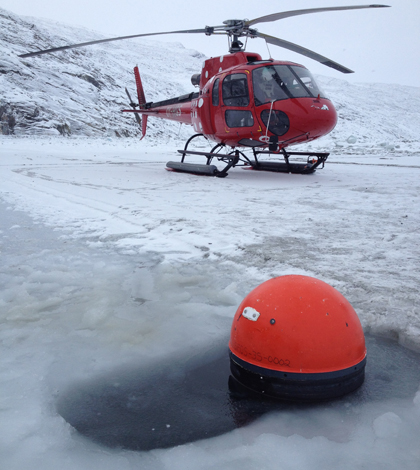Drifting sensors detail meltwater around Greenland ice sheet’s tricky research conditions

Researchers used a helicopter and boat to deploy 14 drifters between 2011 and 2013. (Credit: Kunuk Lennert, Greenland Climate Research Center)
The Greenland ice sheet is climate change’s frozen hourglass: As the world warms, the ice sheet melts away, slowly dripping into the Atlantic where it influences oceanic circulation.
If the entire Greenland ice sheet were to melt, the global sea level would rise by 7.2 meters, drowning most coastal cities. For decades, scientists have studied the glacier and its meltwater in an effort to track the effects of global warming, and better understand the chemical and thermal reactions that occur when meltwater meets the ocean.
Their efforts, however, have not gone without challenge.
“One of the golden problems in glaciology and oceanography is trying to measure the end result of accelerated melting in Greenland,” said Peter Winsor, associate professor of oceanography at the University of Alaska. “When all that freshwater hits the ocean, we have trouble measuring where it’s from and where it’s going.
Attempting to distinguish between the meltwater and ocean water is only part of the issue. The narrow, winding fjords of Greenland’s glacial coast are dotted with icebergs capable of destroying most small craft and autonomous measurement platforms, forcing scientists to study from deeper waters. Use of larger, sturdier vessels only complicates things further.
“Even if you go out there with a research vessel, you’re kind of destroying the signal you’re trying to measure by ploughing through that water,” said Winsor, co-author of a study in the journal EOS detailing an innovative meltwater monitoring technique.
The solution to these problems came in the form of small, satellite-tracked drifters designed to monitor water conditions and float through fjords while withstanding a hefty serving of blunt trauma. Resembling a floating Roomba, the domed devices recorded conductivity, temperature and depth at surface level, 7 and 15 meters of depth. The data and GPS coordinates were then transmitted to an Iridium satellite every hour, a real-time process that afforded better research than earlier deploy-and-collect methods.
“It enables adaptive sampling,” Winsor said, explaining that real-time data allows researchers to respond to significant readings. “It’s a much more dynamic way of measuring meltwater from the ice sheet.”

Satellite-tracked drifters floated through fjords while monitoring water conditions and withstanding a hefty serving of blunt trauma. (Credit: Kunuk Lennert, Greenland Climate Research Center)
Researchers from the University of Alaska and the Greenland Climate Research Center in Nuuk used a helicopter and boat to deploy 14 drifters between 2011 and 2013. The project, funded by the Research Center, revealed a number of interesting features of the fjord system and the glacial meltwater coursing through it.
“This freshwater moving around in the system…can go from sitting around, to having these very direct movements where it’s moving multiple meters per second down the fjord, which is very fast in oceanography,” Winsor said.
Winsor listed three other surprising discoveries about glacial meltwater in Greenland’s coastal fjords: “It looks like the system is pulsating, it’s more stratified than we thought it was, and the changes between low and high salinity are much greater than we thought.”
Initially, the researchers had believed that the transition from low to high salinity took place over a long stretch of ocean. But data gathered by the drifters showed that the gradient was in fact rather steep, spanning only a few kilometers. Vertical profiling revealed an unexpected level of stratification: a difference in salinity of 20 or greater occurring over 70 meters below the surface.
Although the drifters were durable, they weren’t fully foolproof. Winsor said the drifters occasionally tangled their tethers and drogues, or became lodged in ice. Lucky for the researchers, the residents of Nuuk were often willing to help free the devices. One brave soul even dove into the frigid water to unstick a drifter.
Winsor said he and his co-authors are proposing a continuation of the study that would expand its scope with the inclusion of underwater gliders.
“We’re hoping to do this again, but scale it up with more drifters and gliders and nail down in better detail how this system undergoes change,” Winsor said. “We’re excited about that.”
Top image: Researchers used a helicopter and boat to deploy 14 drifters near the Greenland ice sheet between 2011 and 2013. (Credit: Kunuk Lennert, Greenland Climate Research Center)




0 comments